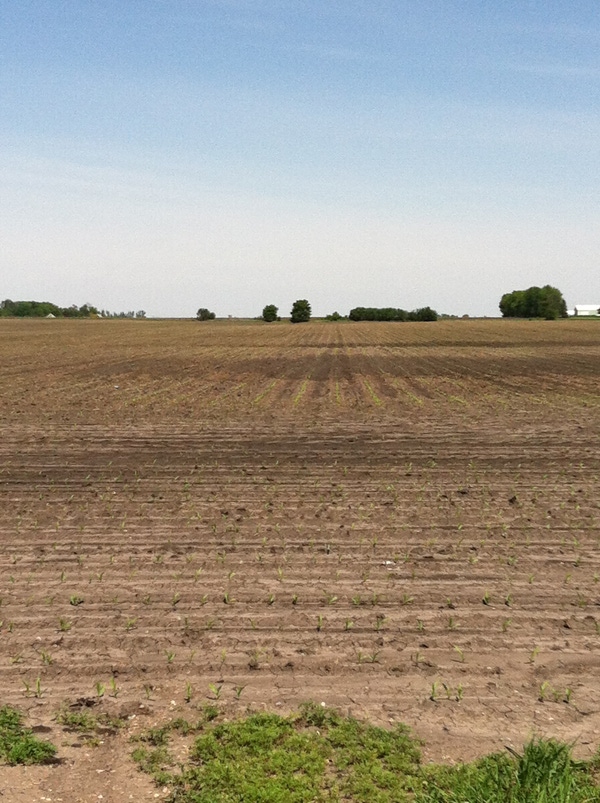April 4, 2013

The priority for spring sampling should be fields where corn in 2013 will follow corn (from which fall samples were taken) in 2012. We suggested last fall that any spring sampling done in order to adjust rates for the 2013 corn crop should best be done close to corn planting time, or at sidedress time. However, it would be useful if at least some of those sites where fall soil nitrogen (N) levels were high could be sampled within the next few weeks so that we could better guess how much additional sampling would be useful.
I suggest that sites with fall nitrate-N above 25 ppm in the top foot (that is about 25% of Illinois sites) be sampled first, but any and all sites can be re-sampled if volunteers are willing to do this. (All those who coordinated sampling last fall and who requested forms and shipping materials through me will get an email in the next few days with brief instructions. The process will be the same as it was last fall, with samples sent to A&L for analysis, and funding provided through C-BMP. Those who sampled under GROWMARK’s direction last fall will continue in that program this spring. Those who did not sample fields last fall but would like to do so this spring are also invited to participate. Instead of sending requests through me, however, we ask that those sampling this spring for the first time send requests to Jean Payne [email protected] at the Illinois Fertilizer & Chemical Association, who will pass along the request for sampling materials and instructions.)
It might be difficult to get the deep (1-2 ft.) samples in fields where soils remain wet. We think the 1-ft. sample will show us how much N rate adjustment might be appropriate. Those willing and able to take samples from the second foot are encouraged to do so, however.
Like what you're reading? Subscribe to CSD Extra and get the latest news right to your inbox!
It is best to take samples before any N has been applied in the spring, though we can avoid the band if, for example, some starter was used at planting and sampling is done after that. Combine in a bucket enough samples to represent the area you want to represent, and take a subsample of this to send to the lab for analysis. Soils should be sent for analysis as soon as possible, and kept refrigerated if needed, to minimize N transformations before analysis.
Adjusting N rates based on spring sampling
The pre-sidedress N test (PSNT) and the pre-plant N test (PPNT) were developed to make N rate adjustments based on N already present in the spring. Adjustments are not generally suggested if the soil has less than 10 ppm of nitrate-N in the top 6-7 in. (10 ppm is about 20 lbs. of nitrate-N per acre), and no additional fertilizer N is suggested if the surface soil has more than 25 ppm nitrate-N (some states use 20 and some use 30 ppm as this limit). Fertilizer N rates are decreased as surface soil nitrate-N increases from 10 to 25 ppm.
Because of uncertainty in sampling, many universities suggest making adjustments as ranges; for example, the N application rate might be reduced by 30-50 lbs. N/acre if the soil has 10-15 ppm of nitrate-N; by 60-120 lbs. N if the soil has 15-20 ppm, etc. In practice, adjusting N rate based on nitrate-N present has often been most useful in fields where a lot of organic N – from manure or forage legumes grown previously – was added, in which case it is a test for how much N mineralized. Spring soil N testing also requires sampling and then waiting for results during a busy time. But it can be used if we suspect that there are more than normal amounts of soil N. In cases where there has been wet weather and some N loss, it can also be used to help decide whether or not to make a supplemental N application.
While the University of Illinois has not actively promoted the use of the PPNT or PSNT, it is logical to apply less than full N rates if spring samples show an appreciable amount of soil N already present. We think that a reasonable way to do this is to calculate pounds of nitrate-N per acre (ppm of nitrate-N in the top foot times 4) and to subtract this from the normal N rate. It may be safer not to make any adjustments if nitrate-N is less than 10 ppm, since we would consider low levels to be normal. But as an example, finding 20 ppm in a sample would suggest a reduction of 80 lb. N/acre in the fertilizer N rate. That’s conservative – 30 ppm would rule out any more N under the PSNT guidelines in use, but would mean lowering rate by 120 lbs. based on what we’re proposing.
Sampling uncertainty does mean some uncertainty in N rate adjustments. That’s a concern, especially if we sample only a small area in the field. So spring resampling in only the small area where fall samples were taken under the N-Watch program, while it meets the important objective of measuring changes from fall to spring, may not be adequate for making adjustments for a whole field. At minimum, samples taken for N rate adjustments should be taken from different soil types in a field to see if soil N levels have enough consistency to warrant adjustments.
You might also like:
Moist Soil Sample Provides Precision, Better Accuracy in Estimating Potassium
You May Also Like




